......Return To Mine & Other Bonneville Car Construction Pages
...........Previous Page...................................................................................Next Page.
.......................----8 Cyl. to 4 Cylinders -- Page 5 ---
At first my lakester was going to be powered by a sbc (small block chevy) running on only 4 cylinders to get down into the F (183 cu. in.) class. Others have done this with varying degrees of success. One of the most famous was the Larson-Cummins streamliner that ran over 300 in the '60's (see bottom of this page). The most recent to do this with success is George Fields and his 125 Trackmaster competition coupe that runs a Keith Black motor on 4 cylinders (I'm not sure on this car if it is running the motor as a V-4 or using only one bank).
Others I've talked to have had less than successful luck trying to run a V-8 motor as a V-4. One person I talked to that ran balance weights on the crank throws in a hemi had problems bending the crank. On his the bob weights were allowed to rotate (float on the crank) next to the working rods.
I talked to another person that I believe was running a sbc as a V-4 and he made the bob weights so that they didn't rotate on the crank and he broke the crank if I remember right with the harmonic balancer coming off. Both of these conversions took place a couple years ago, so if you were one of the guys I talked to please up-date me on your thoughts on this.
I think Crowler in the 60's or 70's ran a 4 cylinder sbc with the piston tops cut out. I think this was a turbo motor, but I would like more info on this effort if anyone as any.
.......................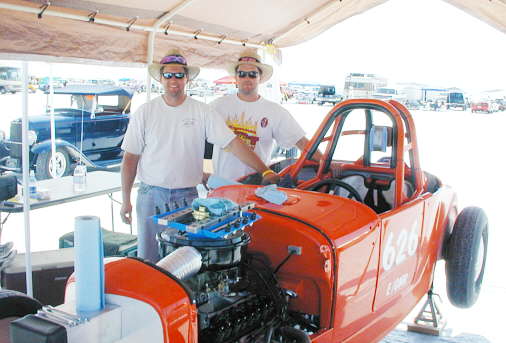
Ken & Nick Smith's ( Hot Rod Works ) roadster. This car now runs a normal 8 cylinder small block chevy, but first ran a 7 cylinder sbc. They deactivated one cylinder to get the car down into the E motor class. I don't believe they set a record in this configuration, but I think they came very close. They had a few new motor/first time on the salt type problems, but I don't think any of them were directly related to running the motor as a 7 cylinder. I think they deactivated either # 7 or # 8. Hopefully Ken will re-fresh my memory on this.
...............................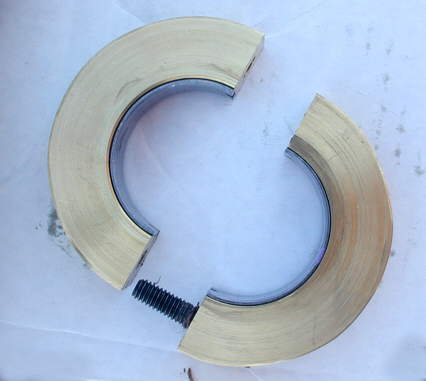
They machined a piece that went on the crank to represent the missing rod/piston. When someone does this it typically weighs 100% of the big end end weight (big end of rod and rod bearing) plus 50% of the small end weight (small end of the rod, piston, piston pin and rings). I believe in their case they used a .005 crush bearing to to keep this piece from rotating on the rod, but I'm not absolutely sure of that.
Ken e-mailed me more info on their car and I'll paste it in here:
We started with a swapmeet 283 short block with some heavy TRW dome pistons. We removed one piston and rod assy and replaced it with a brass donut the same weight as the balancing bob weight (see picture above). We plugged the lifter holes to control the oil, and set the plug to fire into a machined dummy hole bolted to the back of the block (This was after we had tried just grounding the plug and burned up a couple of MSD modules (once during a record return run). We first set it up with a set of 2.02 chevy iron heads, a Vic Jr. intake and a swapmeet holly carb with a flat tappet cam. We dynoed it at close to 300 hp. We proceeded to flatten a cam lobe on the first trip to Bonneville with best licensing run of 153mph on a 159 record in E/GMR. At the World Finals in 01 we set the record at 162, I believe. We ended up with a top speed of 170 and learned a lot during the process. I think we could have gotten a little more out of it, but had made the decision to change classes to C/STR.
We made about 40 passes down the short course with this set up. We really made a lot of mistakes during the whole
learning process as we had never landspeed raced before.
Ken Smith
.........................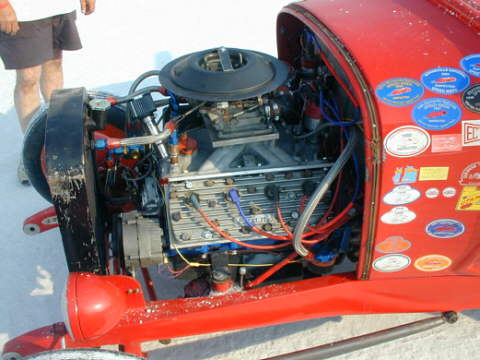
This roadster took a different approach and ran as a 4 cylinder sbc using only one bank (I'll let you figure out which one :-) ). Russ Eyres spent a fair amount of time explaining why he only runs one bank of the small block vs. 2 cylinders on each bank (V-4 configuration). Here again my memory might not serve me right, but I think the basic premise was that the power strokes on sbc V-4 would want to tear the motor apart. Thus most 4's are opposed 4's in a flat configuration with the crank throws 180 degrees apart. What he is talking about might have resulted in the broken and bent crank mentioned above.
..................................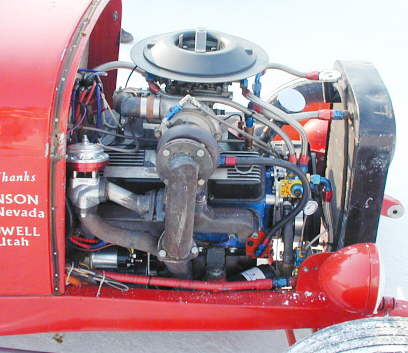
After talking with him a while he had me convinced that if I was going to build a 4 cylinder sbc this would be the approach I would take. When he builds these motors he cuts the small ends off 4 of the rods as close to the crank as possible and tries to get the cap side and the other side within 4 grams of each other. Next, get all of the cutoff rods the same weight. (Note: he doesn't try and achieve the bob weight approach mentioned above.) Then he says you can balance the crank by drilling holes in it in the right places. If your balancer doesn't have a good grip on this I would think about contacting Russ (e-mail me) as he has someone who is capable of doing this.
Another car that ran as a 4 cylinder was the Larson-Cummins streamliner. There is more info on that car on the Rod & Custom Magazine Site ( HERE ). They built a 183 cu. in. motor using a 1959 265 block with all 8 cylinders and a 5/8-inch de-stroked crank. To build their 120 cu. in. motor they ran the two center pistons on one side the the two outer on the other making it into a V-4 which worked for them.
The other application of converted V-8's is the circle track SESCO motors and Scat Motors.
I've found reference to the SESCO in both chevy and Mopar configurations. These motors took the approach of using only one bank of the V-8 and usually sawed off the other bank and used a special crank and other special parts. They were successful for only a short period as far as I can tell. Do a web search on them for more info. These motors are out there and you can find them for sale and I believe they are still raced on occasion.
.................................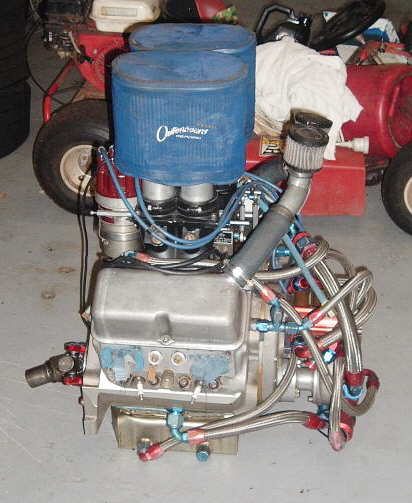
(The picture above came from a friend who got it off the internet some time ago. If it is yours and you don't want it posted here please let me know or give me your name, so I can credit you and/or your site -- Thanks, Sum)
The picture above shows a Scat V-4. It is the front and rear of a Chevrolet V8. It uses the front two throws and the rear two throws of a Chevy crank. It has an "odd-fire" firing order where the throws are 180 degrees apart but the sequential firing on the left side gives power pulses that are not very smooth. Normally the heads are aluminum that are cut down and re-welded together. Very nice looking motor. Scat made the cranks for these, but I don't know if they are still produced.
I'd be interesting in any other pictures, info, history of V-8's that have been converted to 4's.